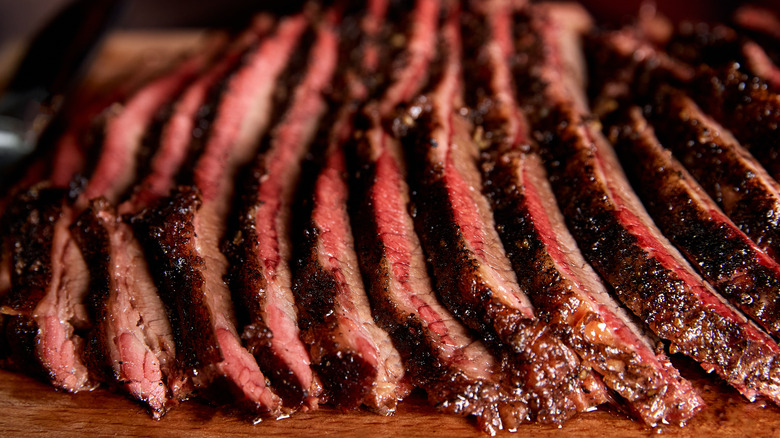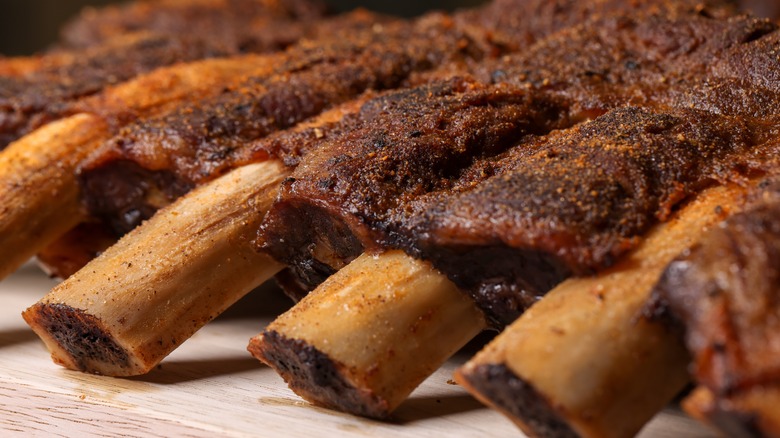The Right Wood Chips For Barbecuing Beef, According To A Grill Master
While there are plenty of mistakes that you can make when hosting a summer barbecue, pairing the wrong wood chips with your protein is one that's easy to avoid. If beef is on the menu, we have some guidelines straight from professional barbecue chef, Silvio Correa. He's the grill master behind Hermosa Beach's Sivlio's Brazilian BBQ, as well as Silvio's Brazilian Barbecue Catering Company and TROPICALI Brazilian Kitchen. Does he know his stuff? Given that he once served up a full two tons of barbecue during a weekend at Coachella, it's safe to say that's a definite affirmative.
We wanted to find out what a professional had to say about getting the most out of our summer barbecues, so we asked him what he recommended for beef. Keep this tip in mind, and you'll avoid a major pitfall. "Hickory and oak are top choices for grilling beef, particularly cuts like brisket or ribs," Correa said. "Hickory offers a robust, bacon-like smokiness that complements the hearty nature of meat, while oak provides a more subtle yet rich flavor without overwhelming the meat. Both woods burn hot and steady, ensuring a consistent smoke." Either choice is excellent, and there's some fascinating science — and history — behind these iconic pairings.
Oak has long been a favorite wood for Texas barbecue
Some areas of the country have developed their own regional style of barbecue, with different sauces, flavors, preferred proteins, and cuts of meat. Head to Texas, and you'll find that it's heavy on the beef — particularly brisket. There's no denying that Texas brisket stands out from the rest, partly because of that oh-so-beautiful bark that develops and partly because of the most common choice of wood: post oak.
Post oak grows in abundance across central Texas, which just happens to be the heart of Texas barbecue. It has a long history that's intertwined not only with barbecue but the state's ranching and livestock history. It's called post oak because, going back to the 19th century, cattle ranchers recognized the wood's characteristic toughness and disease resistance as ideal for building fence posts.
And it didn't take long for grill masters and pitmasters to learn what made this wood invaluable for smoking, particularly because the bold, strong flavors of a really good cut of beef need to be smoked over a wood that imparts an equally strong flavor. Oak checks all the boxes: It imparts a stronger flavor than woods like apple — but doesn't overwhelm the flavor of the meat — and once it's aged and dried, it's very dense and long-lasting.
Hickory wood is favored for bringing a delicious bacon flavor
Sometimes, things come together in a way that makes it seem as though they were just meant to be. One of the most widely available woods across the East Coast and through the heartland of barbecue is hickory — and it just so happens that it's also pretty perfect for adding not just a strong flavor to meat but a delectable bacon flavor, too. As we said, this was just all meant to be.
Hickory, too, checks all the boxes for what makes an ideal wood for grilling and smoking. It's affordable, widely available, burns very hot, and is long-lasting. Add in that bacon flavor, and what more does anyone want? There are, however, a few things to remember when reaching for hickory.
The reason it works so well with beef is the strong flavor it imparts, but it is possible to overdo it. It can give a bitter taste along with that sought-after smoky bacon goodness, so you might want to keep a close eye on how much wood you're adding. Hickory can also be paired with other woods — like apple or cherry — and there's more good news here, too. That same flavor will work well with almost any veg you add to the grill as well, making this a great all-around choice.


